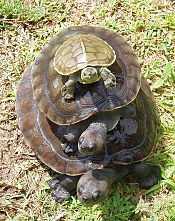| Chinese stripe-necked turtle |
 |
|
| Conservation status |
| |
|
| Scientific classification |
| Kingdom: |
Animalia |
| Phylum: |
Chordata |
| Class: |
Reptilia |
| Order: |
Testudines |
| Suborder: |
Cryptodira |
| Superfamily: |
Testudinoidea |
| Family: |
Geoemydidae |
| Genus: |
Mauremys(previously Ocadia) |
| Species: |
M. sinensis |
|
|
| Binomial name |
Mauremys sinensis
(Gray, 1834) |
|
|
|
|
|
|
|
|
|
|
|
| Synonyms[1] |
- Emys sinensis Gray, 1834
- Emys bennettii Gray, 1844
- Graptemys sinensis Agassiz, 1857
- Clemmys bennettii Strauch, 1862
- Clemmys sinensis Strauch, 1862
- Emys chinensis Gray, 1870 (ex errore)
- Ocadia sinensis Gray, 1870
- Testudo anyangensis Ping, 1930
- Pseudocadia anyangensis Lindholm, 1931
- Ocadia sinensis changwui Tao, 1988
- Ocadia sinensis sinensis Artner, 2003
- Mauremys sinensis Spinks, Shaffer, Iverson & McCord, 2004
|
|
The Chinese stripe-necked turtle (Mauremys sinensis), or Golden thread turtle, is a species of turtle in the Geoemydidae (= Bataguridae) family. It is found in China (Hainan, Guangdong & Fujian), Taiwan, and northern & central Vietnam.
Like many other Geoemydidae, this species hybridizes vigorously with related and not-so-closely related members of its family. In captivity, hybrids have been produced between this species and Japanese pond turtle and the Chinese pond turtle, as well as with a male Cyclemys (oldhami) shanensis. The supposed species Ocadia glyphistoma is a hybrid between a male O. sinensis and a female Vietnamese pond turtle. A species nearly extinct in the wild. Ocadia philippeni was also shown to be of hybrid origin, a male Ocadia sinensis with a female Cuora trifasciata. Both are either naturally occurring or bred for the pet trade. Any individuals that are available as pets therefore need to be kept separate from other members of the family to prevent hybridization, especially considering that the Chinese stripe-necked turtle is threatened by overhunting and habitat destruction in the wild.
It is one of the two most commonly found species used for divination that have been recovered from Shang dynasty sites.[2]
Footnotes
References
- Asian Turtle Trade Working Group (2000). Ocadia sinensis. 2006. IUCN Red List of Threatened Species. IUCN 2006. www.iucnredlist.org. Retrieved on 29 July 2007.
- Buskirk, James R.; Parham, James F. & Feldman, Chris R. (2005): On the hybridisation between two distantly related Asian turtles (Testudines: Sacalia × Mauremys). Salamandra 41: 21-26. PDF fulltext
- Keightley (1979): Sources of Shang History: The Oracle-Bone Inscriptions of Bronze Age China. David N. Keightley. University of California Press. 1979.
|
|---|
| | | | Suborder |
|
|---|
| | Cryptodira |
|
|
|---|
| |
|
Carettinae | |
|---|
| Cheloniinae |
- Chelonia
- Eretmochelys
- Natator
|
|---|
|
|---|
| |
|
|---|
|
|---|
| |
|
|---|
| |
|
|---|
| |
|
|---|
|
|---|
| | Pleurodira |
|
|
Chelinae | |
|---|
| Chelodininae | |
|---|
| Hydromedusinae | |
|---|
|
|---|
| |
|
|---|
| |
|
|---|
|
|---|
|
|---|
| |
|


